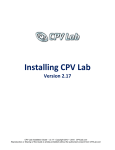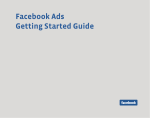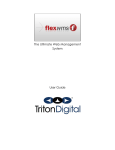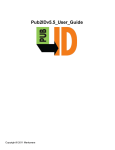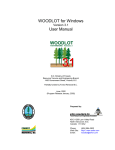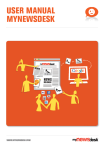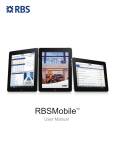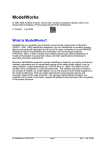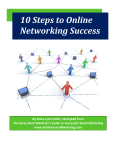Download DOs - The Newspaper Works
Transcript
The Newspapers Today: Print & Online (Part II) User Manual is a support tool for sales forces as they take the report to market and engage with those responsible for the channel/media selection. Please note that this manual is intended for publisher use only and should not be distributed more broadly. If there are any other areas you would like input or support on, beyond the scope of this manual, please contact your trade marketing team or Lucia Elliott / Lisa Overall at The Newspaper Works on (02) 9692 6300 or via [email protected] [email protected] • Background & report content • Rollout strategy – – – – Launch process Launch components Media agency presentations Rollout calendar • Sales force support materials • Practical applications in-market • Draft Q&A questions Part 1 of Newspapers Today (Print), which was released in July 2008, explored newspapers’ relevance and identified a unique positioning for the medium in the minds of Australian consumers within the modern media landscape. It also prompted the need for a greater understanding of the relationship between printed newspaper and newspaper websites. The three chapters of Newspapers Today Part 2 provide: a) A health-check on newspapers’ unique positioning, two years on. b) Evidence that will help combat misconceptions that newspaper websites are cannibalising printed newspapers, and c) A fresh take on how Australians perceive newspapers, as brands in their own right. In all they demonstrate that: 2 years on, newspapers hold an even stronger position in the minds of Australians Newspapers and their websites play complementary roles. Newspaper websites are not cannibalising printed newspapers. Australians see newspapers as powerful multidimensional brands There is a lot to communicate from the findings of Newspapers Today Part 2. As each chapter can operate as a standalone or combine to provide an holistic perspective, the rollout will be phased so that communication of the findings are clearly defined. The phasing of these chapters will apply in a number of ways: • Video segments (four in total – one for each chapter + Exec Summary) • Press and online advertising (three ads featuring each chapter’s killer findings) • MediaI (bite size findings from each chapter phased over three weeks) • PR activity (Three CEO interviews focusing on different chapters) • Support materials (eg. PDFs for each chapter + Exec Summary version) Contact point for sales force support materials 2-5 Feb For those attending media agency presentations 10-12 Feb 10-12 Feb Preparation for launch exclusive interviews 10 Feb onwards Video ‘chapters’ deliver key findings from report phased across launch weeks March onwards On request, via Effectiveness Champions, for sales teams presenting more broadly post launch • Combined briefing to key press/trade journalists • CEO exclusives offered to The Aus, SMH & AFR. • Video segments offered exclusively to trade press website (eg. Adnews) • Demo cuts released mid March provide additional PR opportunity. • Advance copies to industry figures for PR commentary. • Copies to publisher sites. • 400+ copies mailed by The Newspaper Works to database. • Leave behinds at media agency presentations. • Website download and registration for hard copy mail-out. • Full database e-alert blasts. • Video ‘chapter’ segments to view on website, YouTube channel, trade press &, publisher trade sites • Press and online activity in Media sections (mastheads and corresponding web pages) • Four week MediaI schedule 35 media agencies to be targeted by The Newspaper Works: Sydney w/c 15 February Melbourne w/c 22 February Brisbane w/c 8 March Timing pending confirmation of CEO’s PR activity/scheduling Senior agency personnel (Management/Planning Directors/Strategists) and communication planning influencers only to attend. Joint senior level publisher representation requested. Presentation of key findings 25 minutes maximum. When meetings are finalised, a meeting schedule will be circulated for publishers to nominate representatives. A PDF version of this calendar is provided separately for greater detail • Video segments providing key findings in easy viewing form for initial education/training and for subsequent use embedded into own presentations by sales forces where applicable. • PPT presentation version of full findings to cut and paste into own presentations. • PDF summaries to use as talkers/leave behinds with clients (see following page for examples) • Chapter 1 (Unique positioning of newspapers two years on) • Chapter 2 (The complementary roles) • Chapter 3 (Newspapers as multi-dimensional brands) • Executive Summary of full findings • User manual – how to use findings from NT2 in responding to briefs/pitches. • Q&A crib sheet. • Demographic cuts in PPT and PDF form (released mid March). • PDF summaries for each of the chapters provide you with a simple (and portable) way to deliver the key findings from the report when time pressures don’t allow for a more comprehensive presentation. • Qualitative research was conducted in December 2007 by independent market research company The Leading Edge. • Eight focus groups and four in-depth interviews were conducted in both metro and regional locations (Sydney, Melbourne and Orange). All participants were regular users of newspapers in print and online, and were aged from 18-61. • The qualitative study was undertaken to help understand how and why Australians used newspapers and their websites. It also helped identify themes for further exploration in quantitative research. • Quantitative Research uses structured questions (conducted in surveys, often online) where the response options are pre-determined and involve large respondent numbers. It concerns itself with objective, quantified and statistically valid measures. What, when, who, how people think and act as they do. • It was used in this study to determine what had changed in relation to; – Newspapers unique positioning since 2007 – How dual users of newspapers and their websites use each respective platform – How newspapers and their websites performed, as brands compared to well known contemporary brands. • Fieldwork was undertaken between 30 Jan – 7 Feb 2009 with 1,029 Australians aged 14-69. Quotas were imposed on age, gender and geography and the data post weight to known population characteristics as per the Australian Bureau of statistics, to ensure it was an accurate representation of the Australian population. • Figures in the report are accurate to within +/- 3% at the 95% confidence interval Organise one-on-one presentations with media strategists and planners first. The benefit of doing so is that it will give strategists a chance to digest the information and then ask questions that are relevant to their target audience and their brands. It will be a missed opportunity if the report is presented at the outset in a larger/broader forum, because the client-specific conversations are less likely to occur. Ascertain if your contact recalls seeing Newspapers Today Part I. Establishing this fact will help you to weight the time/emphasis you place on particular sections. Provide the hard copy of the report as a leave-behind for strategists to read after the presentation. Follow up approximately a fortnight later asking if they have any further questions or if they would like the results from Newspapers Today Part II cut by their target audience. If your key contact has been exposed to the report already, perhaps you might pull out/post-it-note a couple of points relevant to their business to draw their attention to it and reinforce what they’ve already seen. Alternatively you could use it as an SUGGESTED opportunity to provide additional copies for their clients. DOs The report’s value comes from getting the strategist or advertiser talking about a brief they’re working on, identifying the strategic role and discussing the merits of newspapers in that context. The three defining attributes of newspapers will always combine to deliver an unrivalled opportunity for advertisers to connect powerfully with consumers, irrespective of the strategic role, so continue to reinforce them. Wherever possible, use the report as a platform to discuss practical applications rather than generic ones. 3. Use the report content immediately in your responses to client briefs. It need only be one or two stats to help support your case, but it may also give you the opening to discuss the content further with planners/strategists. This report provides you with an opportunity to engage with media planners and strategists, so don’t miss the chance by making a mass drop-off of the printed report. Otherwise key targets won’t give the report due consideration if it doesn’t SUGGESTED form part of a presentation/ face to face conversation. DOs If your contact requests a soft copy without having been presented to, press for a presentation. If this is not achievable within the first few weeks of the report’s launch, then ensure a hard copy of the report is delivered as well, rather than just a soft copy. It’s more likely to be read than the PDF version. The soft copy should be a back-up only for key/senior targets. If you feel you have an excess of hard copies at your disposal, please contact [email protected], and we will have them collected and redistributed. 3. The 44pp printed report (which is expensive to produce) is intended for senior/key contacts. Others can download the report from our website for the full report or PDF summaries. If your contact indicates they’ve already seen the report, don’t put your copy away and avoid referencing and utilising it during the course of your conversation. Use it as an active tool, as per Suggested Do’s previously outlined for follow up SUGGESTED presentations. DOs Don’t do all the talking. Engage the planner in your discussions and ask questions that are also relevant to their clients’ business, eg: - What are their overall impressions of the findings? - What relevance do the findings have in particular to their clients’ business and/or briefs they’re currently working on. - Are there any particular targets they would like the Newspapers Today data cut by so that it is more specific to their clients’ needs? SUGGESTED DOs Examples of how use report content to build a case for newspapers and answer a client brief 3. • Look for language in the brief, or from discussions with the planner that can be applied to the audience report (examples follow). • Think about the task that needs to be achieved. Will the absorbing, dynamic or reputable nature of newspapers help? • Compile data from all sources to create your argument • Don’t feel like you need to include everything. Make sure you edit the presentation to make it completely relevant This brand needs attention. A medium that has it’s users undivided attention is an attractive proposition.; A leader sets the agenda, moves first. Newspapers drive the news cycle, break big stories and influence content of other media. This is a great environment for advertisers to borrow by association. Newspaper reader respect content, a state of mind that might be difficult to create elsewhere, or be achieved by a brand alone. It’s a positive environment to borrow interest from. SUGGESTED DOs A couple of slides that help to counter this perception. 3. A likely reflection of the high degree of mental engagement newspaper reading attracts SUGGESTED DOs A couple of slides that help counter this perception. 3. SUGGESTED DOs A slide that could be used to respond to this statement 3. SUGGESTED DOs A few slides that you might use to respond to this statement or query raised by agencies and clients 3. Quotes source; Qual research The Leading Edge” Dec 2007. Quotes were aligned with a practical example and not specific to the Dust storm coverage. SUGGESTED DOs A couple of slides to counter this perception 3. An extensive range of Q&As have been identified in consultation with sales directors, and are currently being prepared. They will answer general questions about the report as well as those relating specifically to the findings in each chapter. However there may be more, so we would appreciate you getting back to us with those you think you will be likely to field in market. An A4 PDF will then be produced and distributed for use by sales forces. Please forward questions to [email protected] by Tuesday 9th February. Thank you.













































